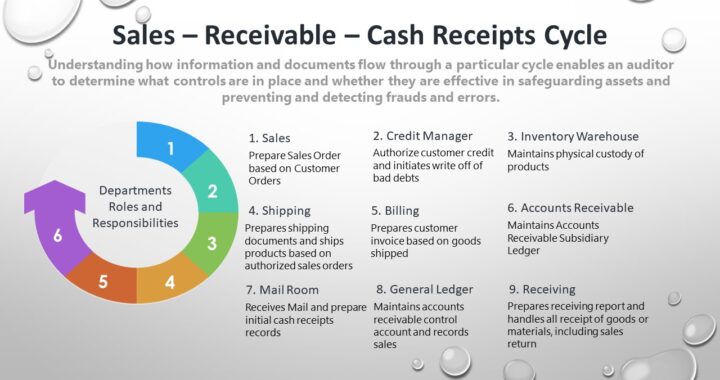Completeness assertion for sales and receivables
Reconciling total amounts in subsidiary ledgers with the general ledger
Performing analytical procedures (e.g., comparing accounts receivable turnover with previous year)
Accounting for the numerical sequence of sales orders, shipping documents, and invoices
Tracing from sales invoices to shipping documents
Accuracy assertion for sales and receivables
Obtaining management representation letters
Evaluating disclosures about reportable operating segments (e.g., geographic areas)
Comparing general ledger balances with financial statement balances
Preparing bank reconciliations
Valuation and Allocation assertion for sales and receivables
Comparing aged accounts receivables schedule with the prior year’s
Tracing subsequent cash receipts
Reviewing delinquent customers’ credit ratings
Testing the allowance for credit losses and write-offs
Existence assertion for sales and receivables
Sending external confirmations
Vouching journals to shipping documents
Cutoff assertion for sales and receivables
Sales cutoff – Testing whether revenue is recognized in the appropriate period
— Tracing shipping documents to accounting records near year end
Cash receipts cutoff – Testing the recording of cash receipts and accounts receivable reduction
— Tracing daily remittance list to accounting records near year end
Rights and Obligation assertion for sales and receivables
Inquiring of management (e.g., whether the accounts receivable is pledged and factored)
Tracing cash receipts to deposits into bank accounts
Determining the right of return, expected returns, and actual returns
Occurrence assertion for sales and receivables
Vouching samples of recorded sales transactions to customer orders and shipping documents
Classification and understandability assertion for sales and receivables
Evaluating
— Classification of
–Sales (minus returns and allowances) as revenue
— Accounts receivables (minus allowance) as current assets
Disclosures of
— Accounting policies
— Pledges and factoring of accounts receivables
— Sales and receivables with related parties
If you have found this blog to be useful, you may share with your friends. Thanks!




